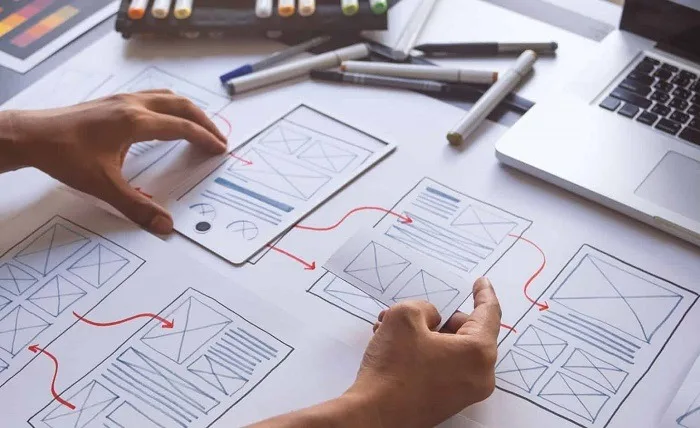In today’s digital era, a well-designed website is crucial for any business or organization. A visually appealing and user-friendly website can significantly impact user engagement, conversions, and overall success. To achieve these goals, web designers must understand and incorporate the important elements of effective web design. In this article, we will explore the key elements that make a website stand out and deliver an exceptional user experience.
Visual Appeal:
The visual aspect of a website is the first thing that captures a user’s attention. Clean and appealing layouts, color schemes that reflect the brand, and high-quality images are essential. Consistent use of fonts, spacing, and visual hierarchy helps to guide users through the content. Visual appeal also includes responsive design, ensuring that the website looks great and functions well across different devices and screen sizes.
User-Friendly Navigation:
An intuitive and well-structured navigation system is crucial for visitors to find what they need easily. Clear and concise menus, logical categorization, and a prominent search bar enable users to navigate through the website effortlessly. Strategic placement of navigation elements, such as sticky menus or breadcrumb trails, ensures that users never feel lost or overwhelmed. You must find Plano city’s best web design agency to achieve world class user experience.
Responsive Design:
In an increasingly mobile world, responsive design is more important than ever. Websites must adapt to various devices, including smartphones, tablets, and desktop computers. Responsive design ensures that the website’s layout, content, and functionality adjust seamlessly to different screen sizes. This approach enhances user experience, increases accessibility, and positively impacts search engine rankings.
Compelling Content:
Engaging and well-crafted content is vital to capture and retain user attention. The website’s copy should be concise, informative, and tailored to the target audience. Utilizing headlines, subheadings, bullet points, and visual elements can break up the text and make it easier to read. Furthermore, the inclusion of multimedia content, such as videos, images, and infographics, can enhance the user experience and convey information more effectively.
Call-to-Action (CTA):
Every web page should have a clear purpose and encourage visitors to take specific actions. Effective use of call-to-action buttons and links helps guide users towards the desired conversion, whether it is making a purchase, signing up for a newsletter, or contacting the business. CTAs should be visually appealing, placed strategically, and accompanied by persuasive copy to drive user engagement.
Loading Speed:
In a fast-paced digital world, users have little patience for slow-loading websites. Optimizing loading speed is crucial for user satisfaction and reducing bounce rates. Compressing images, minifying code, utilizing caching techniques, and choosing a reliable hosting provider are some of the ways to improve website performance. Regular performance monitoring and optimization are essential to ensure optimal loading times.
Consistent Branding:
A website should reflect the brand’s identity and maintain a consistent visual style throughout. Consistent use of brand colors, fonts, logos, and imagery fosters recognition and establishes trust with visitors. Branding elements should be applied consistently across all pages, ensuring a cohesive and professional appearance.
White Space:
White space, also known as negative space, refers to the empty areas between elements on a web page. It helps to create a sense of balance, enhances readability, and allows important elements to stand out. Properly utilizing white space gives the website a clean and organized look, preventing it from appearing cluttered or overwhelming.
Typography:
Choosing the right typography is crucial for effective web design. Fonts should be legible, visually appealing, and align with the brand’s personality. Maintaining consistency in font styles, sizes, and spacing across the website ensures a cohesive visual experience. Additionally, using hierarchy in typography, such as heading styles and paragraph formatting, helps users scan and digest content easily.
Accessibility:
Web accessibility ensures that people with disabilities can access and use a website effectively. Designing with accessibility in mind benefits all users. Considerations include providing alternative text for images, using proper heading tags for content structure, ensuring color contrast for readability, and implementing keyboard navigation options. Of late, it has become mandatory for website owners to go through an accessibility color checker test, in order to ensure that the site’s content is clearly visible and accessible to a user/person with color blindness, and does not form a hindrance to smooth browsing and information finding. Here, an expert in ADA WCAG compliance like “Accessibility Spark” can be of great help in authenticating and implementing your site’s color accessibility status. Accessible web design enables a wider audience to engage with the website and promotes inclusivity.
Intuitive Forms:
Forms are often used to collect user information, such as contact details, registration, or feedback. Designing intuitive and user-friendly forms can enhance the overall user experience. Clear instructions, well-labeled input fields, error validation, and a logical flow contribute to a seamless form-filling process. Minimizing the number of required fields and providing progress indicators can also improve form completion rates.
Social Media Integration:
Incorporating social media elements into web design can extend the reach of the website and promote user engagement. Integrating social sharing buttons allows visitors to easily share content on various platforms, increasing brand visibility. Displaying social media feeds or embedding social media widgets can help showcase user-generated content and build trust and credibility.
Search Engine Optimization (SEO):
Designing a website with SEO principles in mind is crucial for organic traffic generation. Properly optimizing page titles, meta descriptions, header tags, and image alt attributes improves the website’s visibility in search engine results. Additionally, creating a website structure that is easily crawlable by search engine bots and implementing clean URL structures can positively impact search rankings.
Analytics and Tracking:
Integrating analytics tools, such as Google Analytics, enables website owners to gather valuable data on user behavior, traffic sources, and conversion rates. Analyzing these insights helps in identifying areas for improvement and making data-driven decisions to optimize the website’s performance. Tracking user interactions and setting up goals allows for continuous refinement of the design and user experience.
Remember, web design is a dynamic field, and staying updated with the latest design trends, technologies, and user preferences is essential to create impactful and effective websites. By considering these important elements and continually refining your design approach, you can create websites that not only look visually appealing but also deliver exceptional user experiences and drive desired outcomes.
Explore More About Modal Web Design: The Future Of User Experience Or A Passing Fad?
Conclusion:
Designing a successful website involves a combination of creativity, technical expertise, and understanding user behavior. By incorporating the key elements mentioned above – visual appeal, user-friendly navigation, responsive design, compelling content, effective CTAs, loading speed optimization, and consistent branding – web designers can create a website that stands out, engages users, and drives desired outcomes. Remember, a well-designed website is not just aesthetically pleasing, but also functional, accessible, and user-centric, ultimately contributing to the success of the business or organization it represents.



